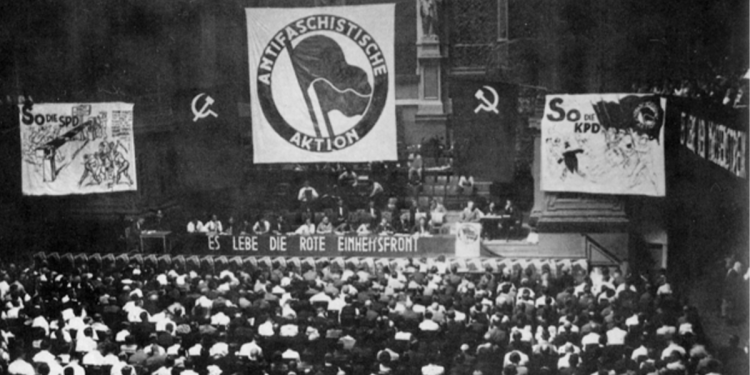BERLIN – 90 years ago, on July 10, 1932 to be precise, a unified congress of “Anti-Fascist Action” took place in Berlin Kreuzberg with around 1,500 participants. This congress can be seen as the founding date of the anti-fascist action, which took place as the prelude to an “anti-fascist struggle week”.
An initiative that was founded to commemorate the 90th anniversary of the founding of the “Antifascist Action” calls for joint actions to commemorate this historic date with the following text:
“On July 10, 1932, around 1,500 people gathered at Bernburger Strasse 22 in the Berlin district of Kreuzberg for the start of an “Anti-Fascist Combat Week”. The delegates present from the KPD, SPD, SAP, Reichsbanner and many independents accepted the invitation to the first national congress of the “Anti-Fascist Action”. Organized by the KPD, this was to be the prelude to a united front in the fight against emergency decrees and Nazi terror. The united front demanded was primarily a political strategy of the KPD, which was primarily directed against social democracy. The call for “anti-fascist action”, which was also called “united front action” for a short time, was about the implementation of the social-fascism thesis. Capitalism and fascism were not distinguished by the KPD, the main political enemy was the SPD. Against these ideological aberrations stood the practical necessity of fighting together on the streets with the Nazis, who were becoming ever stronger. Their political enemy was Marxism, and so they fought the two major Marxist parties SPD and KPD equally.
The emblem with the red double flags, which symbolize the KPD and SPD in a lifebelt with the inscription “Anti-Fascist Action”, appeared on all KPD publications and demonstrations after the founding congress. With the “Anti-Fascist Action” a cross-party collection movement dominated by the KPD was to be created. While the KPD was still able to gain votes from the SPD in the Reichstag elections on July 31, 1932, everything changed a few months later: On January 30, 1933, Adolf Hitler was appointed Reich Chancellor by Reich President Paul von Hindenburg and with the formation of a “coalition government of the national merger” commissioned. On March 24, 1933, the Enabling Act came into force, with which Hitler elevated himself to dictatorship.
The “Anti-Fascist Action” in Germany before 1933 failed. Nevertheless, the symbol and the basic idea of an action unit in the fight against the diverse manifestations of extreme right-wing and neo-Nazi ideologies formed a point of reference for anti-fascists from the 1970s onwards. In the 1980s, the critical review of their own history began, which also led to the transformation of the old symbol into a new one with a red and black flag.
Anti-fascist organizing was and is not an end in itself, but an ongoing necessity that cannot take place in isolation from social debates and developments. The self-critical view of strengths and weaknesses – which makes reflection possible not only in the context of the radical left – should be one of the basics of political action. With this in mind, on July 10, 2022, the 90th anniversary of the “Anti-Fascist Action”, we want to point out the historical reference point with a rally at the place where it was founded and make it visible with a commemorative plaque. On the other hand, we must always look ahead. Therefore, our campaign will be accompanied by an event with a panel discussion on the evening before
The event flyer of the initiative:

More information about the planned events can be found on this website.




